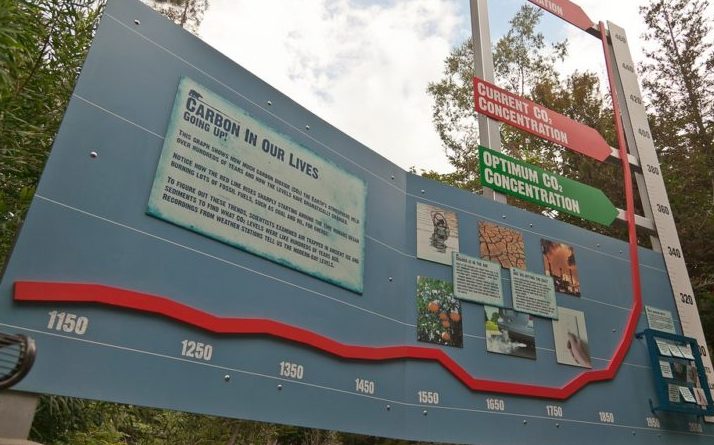400 ppm CO2: Cataclysmic destruction or an opportunity for change?
Photo By Kevin Baird/ CC BY-NC-ND 2.0
Article by Hanna Klaus
Measurements from the Mauna Loa observatory found that atmospheric carbon dioxide reached 400 parts per million (ppm) in August (1). The safe level for atmospheric carbon dioxide concentration is considered to be 350 ppm (7). According to from UCLA, CO2 has not been this high in 15 million years, a time in which global temperatures were 5-10 degrees Fahrenheit higher, sea levels were 75- 120 feet higher, and very little sea ice was in existence (11). Carbon dioxide at this level is greatly concerning because it is the most prevalent heat trapping greenhouse gas contributes to climate change (4). A goal set by the Paris Climate agreement is to prevent global temperatures from rising above 2 degrees Celsius (9).
Carbon dioxide levels fluctuate naturally each year. As plants take in carbon dioxide for photosynthesis in spring and summer, the amount of carbon dioxide in the atmosphere decreases. In the fall and winter, as plants lose their leaves and die and release carbon dioxide back into the atmosphere (8). The time during this natural cycle when atmospheric carbon dioxide is expected to be at it’s lowest is September (5). However, carbon dioxide levels surpassed 400 ppm in prime growth season this year- reaching nearly 408 ppm in May. Measurements from September indicate that carbon dioxide have not fallen back below the 400 ppm threshold (5).
We have been moving toward this breaking point for over a century. The Mauna Loa observatory has been measuring carbon dioxide levels since 1958 when the yearly average was less than 320 ppm (1). The global concentrations have been climbing by approximately 2 ppm each year. This is not the first time in recent history that carbon has reached this level. Levels hit 400 ppm in May of 2013 (1). Since the start of the industrial revolution, carbon dioxide emissions have been on the rise (1, 7). According to NASA, global carbon dioxide levels could reach 1500 ppm within the next century if we continue to emit at the same rate globally (3).
We are already starting to see the effects resulting from a greenhouse gas in the atmosphere at this concentration. This so far has been the hottest ever on record. According to the National Oceanic and Atmospheric Association, August was the hottest month ever on Earth, with temperatures reaching 1.66 Fahrenheit above the twentieth century average (10). Global temperatures have reached 1.5 degrees Celsius increase from pre-industrial levels, which is alarmingly close to the 2 degree Celsius limit set by the Paris Climate Agreement (2). The oceans are a carbon dioxide sink. They balance out atmospheric levels as they increase. If the oceans take up too much carbon, however, they will become more acidic, although they are only expected to rise .5 above its current level (6).
How will we prevent an increase of atmospheric carbon dioxide to 500 ppm, 1000 ppm, or even 1500 ppm? We must drastically cut global carbon dioxide emissions immediately but moving away from coal and natural gas and towards renewable, creating incentives for sustainability, and making the health of our planet a priority on the international agenda.
1.”ESRL Global Monitoring Division – Global Greenhouse Gas Reference Network.” ESRL Co2 Trends RSS. Accessed October 05, 2016. http://www.esrl.noaa.gov/gmd/ccgg/trends/full.html.
- “Flirting with the 1.5°C Threshold.” Climate Central: A Science & News Organization. April 20, 2016. Accessed October 05, 2016. http://www.climatecentral.org/news/world-flirts-with-1.5C-threshold-20260.
- “Graphic: The Relentless Rise of Carbon Dioxide.” NASA. Accessed October 05, 2016. http://climate.nasa.gov/climate_resources/24/.
- “Greenhouse Gases.” EPA. Accessed October 05, 2016. https://www3.epa.gov/climatechange/kids/basics/today/greenhouse-gases.html.
- Kahn, Brian. “Earth’s CO2 Passes the 400 PPM Threshold–Maybe Permanently.” Scientific American. September 27, 2016. Accessed October 05, 2016. http://www.scientificamerican.com/article/earth-s-co2-passes-the-400-ppm-threshold-maybe-permanently/.
- Plass, Gilbert N. “Carbon Dioxide and Climate.” Scientific American. December 04, 2008. Accessed October 05, 2016. https://www.scientificamerican.com/article/carbon-dioxide-and-climate/.
- Romm, Joseph. “What Is the Safe Upper Limit for Atmospheric CO2?” Grist. January 1, 2008. Accessed October 05, 2016. http://grist.org/article/parting-company-with-mckibben-and-maybe-hansen/.
- “Seasonal Fluctuations of CO2 on the Rise.” UCAR. August 9, 2013. Accessed October 05, 2016. https://www2.ucar.edu/atmosnews/just-published/10046/seasonal-fluctuations-co2-rise.
- Schwartz, John. “A Milestone for Carbon Dioxide in the Atmosphere.” The New York Times. October 03, 2016. Accessed October 05, 2016. http://www.nytimes.com/2016/10/04/science/atmospheric-carbon-dioxide-400-ppm.html?_r=0.
- Thompson, Andrea. “Streak of Record-Hot Temps Adds Another Month.” Climate Central. September 20, 2016. Accessed October 05, 2016. http://www.climatecentral.org/news/record-hot-temps-another-month-20715.
- Wolpert, Stuart. “Last Time Carbon Dioxide Levels Were This High: 15 Million Years Ago, Scientists Report.” UCLA Newsroom. October 08, 2009. Accessed October 05, 2016. http://newsroom.ucla.edu/releases/last-time-carbon-dioxide-levels-111074.

